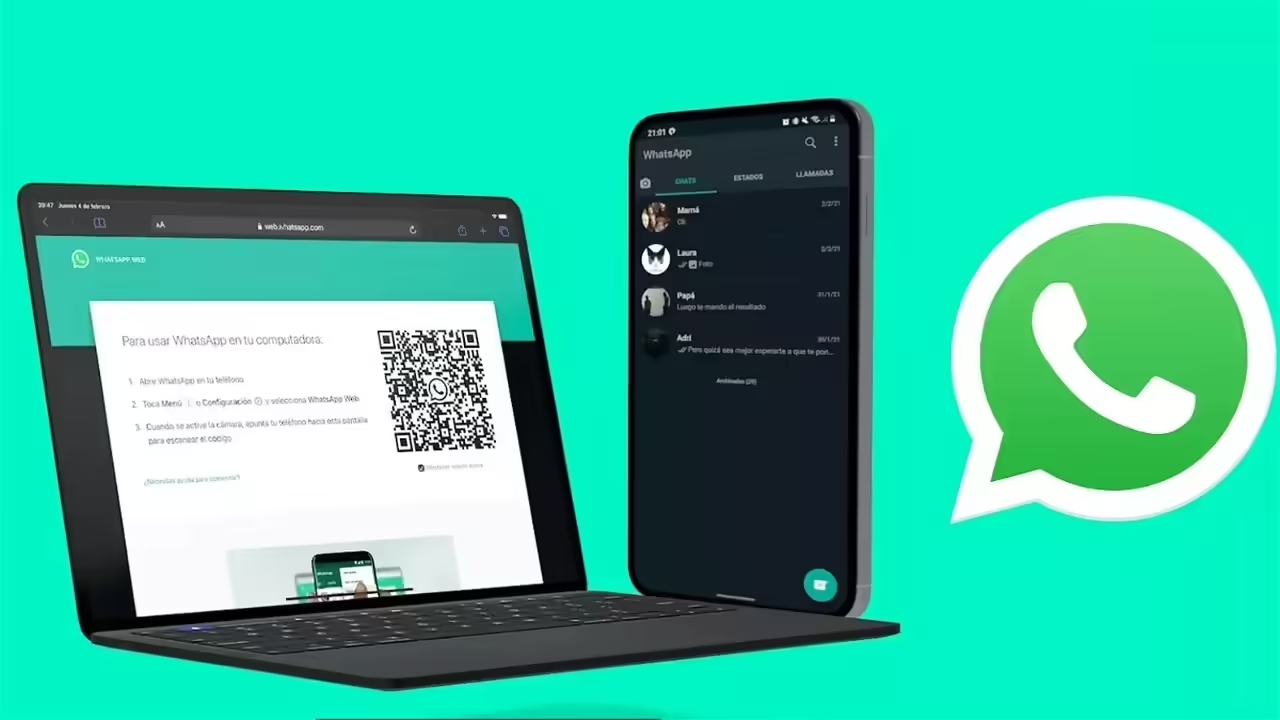
In the dynamic landscape of digital communication, WhatsApp has evolved into a ubiquitous platform, redefining how we connect with our social circles and professional networks. While the mobile app has been the cornerstone of this revolution, WhatsApp Web emerges as a powerful ally, seamlessly extending the user experience from smartphones to desktops. This article explores the fundamentals of WhatsApp Web, offering a concise overview and accentuating the platform’s significance and practical applications.
WhatsApp Web: A Brief Description:
WhatsApp Web serves as a natural extension of the widely-used mobile application, designed to enrich the user experience by providing access through web browsers on desktops and laptops. Conceived to meet the demand for a multi-device communication solution, WhatsApp Web mirrors mobile app conversations and data in real-time.
Users can initiate chats, send messages, share media, and manage contacts from the comfort of their computer screens. The platform’s interface is intuitive, mirroring the simplicity of its mobile counterpart, ensuring a seamless transition for users familiar with WhatsApp’s mobile application.
The Significance and Utility of WhatsApp Web:
Accessibility Across Devices:
WhatsApp Web acts as a crucial link between mobile and desktop environments, enabling users to stay connected without being bound to their smartphones. This accessibility is particularly valuable for those who spend significant time working on computers or prefer the convenience of a larger screen.
Synchronized Conversations:
A standout feature of WhatsApp Web is its ability to synchronize conversations in real-time. Messages sent or received on the mobile app instantly reflect on the desktop version, ensuring a unified communication experience. This synchronization eliminates the need to switch between devices to catch up on ongoing conversations.
Enhanced Typing Experience:
The larger keyboard and screen real estate offered by desktops contribute to an enhanced typing experience. Users can respond to messages more efficiently and comfortably, especially when dealing with lengthy or detailed conversations.
Seamless File Sharing:
WhatsApp Web facilitates effortless file sharing between devices. Users can seamlessly share documents, images, and videos directly from their computers, streamlining collaboration and communication.
Multitasking and Productivity:
For those managing multiple tasks on their computers, WhatsApp Web enhances multitasking capabilities. Users can maintain communication while working on projects, thereby boosting overall productivity.
Accessing WhatsApp Web
WhatsApp Web offers a convenient way to use the messaging platform from your web browser. Here’s how to access WhatsApp Web and the requirements for a seamless experience.
Accessing WhatsApp Web from a Browser:
Open Your Browser: Launch your preferred web browser on your computer. You can use Google Chrome, Mozilla Firefox, Safari, or Microsoft Edge, among others.
Go to the WhatsApp Web Website: Navigate to the official WhatsApp Web website by entering the following address in the address bar: web.whatsapp.com.
Scan the QR Code: Open the WhatsApp application on your mobile phone and go to the settings section. Select the “WhatsApp Web” or “Linked Devices” option. Use the QR code scanning feature of the app to scan the QR code displayed on your computer screen.
Wait for Synchronization: Once you have scanned the QR code, your WhatsApp session will synchronize with the web application. You will see your conversations and contacts on your computer screen.
That’s it! Now you can use WhatsApp Web from your browser and enjoy the convenience of sending messages from your computer.
Requirements and Compatible Devices:
Up-to-Date Browser: Ensure that you are using the latest version of your browser to ensure compatibility and optimal performance. Popular compatible browsers include Google Chrome, Mozilla Firefox, Safari, and Microsoft Edge.
Stable Internet Connection: Both your computer and mobile phone should have a stable internet connection for proper synchronization between devices.
Compatible Mobile Phone: WhatsApp Web requires your mobile phone to be turned on and connected to the internet to function. The application is compatible with both iPhone and Android phones.
By following these simple steps and ensuring you meet the mentioned requirements, you can easily access WhatsApp Web and enjoy a broader and more versatile messaging experience.
Getting Started with WhatsApp Web: Initial Configuration
As our methods of communication expand across various devices, the integration of messaging tools becomes paramount. WhatsApp Web, an extension of the widely-used mobile app, allows users to effortlessly switch between their smartphones and desktops.
Linking Your Mobile Phone to WhatsApp Web:
The initial setup of WhatsApp Web involves a simple process to link your mobile phone with the desktop application. Open the WhatsApp app on your smartphone, access the settings menu, and choose “WhatsApp Web” or “Linked Devices.” Scan the QR code displayed on the computer interface using your mobile device’s camera, and once scanned, your conversations will appear on the desktop.
Configuring Notifications and Preferences:
After successfully linking your mobile phone to WhatsApp Web, it’s crucial to tailor the application’s settings to your preferences. Access the settings on WhatsApp Web, explore the “Notifications” or “Notifications & Sounds” section to customize alerts for messages and calls. Further customize preferences, including chat settings, privacy options, and media download preferences, to align the application with your preferences.
Logout and Security Options:
Consider exploring additional features such as two-step verification and session management within the settings. These options add an extra layer of security to your WhatsApp Web experience. Configuring these security features can enhance the overall safety of your messaging platform.
WhatsApp Web User Interface: Navigating the Digital Conversation
As the boundaries between mobile and desktop communication blur, WhatsApp Web emerges as a versatile bridge, allowing users to seamlessly transition between devices.
Description of the User Interface:
WhatsApp Web maintains a clean and intuitive interface, mirroring the simplicity of its mobile counterpart. Here’s an overview of its key elements:
Chat Panel: Dominating the screen, the chat panel displays your ongoing conversations. Each chat is represented by the contact’s name and profile picture. Clicking on a chat opens the conversation thread on the right side of the screen.
Conversation Thread: On the right side, the conversation thread unfolds. Messages are displayed in a familiar chat format, with your messages aligned to the right and your contact’s on the left. Media, such as images and videos, are embedded within the conversation.
Left Sidebar: The left sidebar hosts your list of contacts and groups. Clicking on a contact or group updates the conversation thread on the right. This sidebar also houses settings and profile options at the bottom.
Top Bar: The top bar contains essential functions, including a search bar to locate specific chats, an icon for starting a new chat, and a menu for additional options such as accessing your profile, changing your status, and more.
Functions and Tools Available in the Web Version:
WhatsApp Web offers a robust set of functions and tools, making it a comprehensive platform for communication:
Text Messaging: The core function revolves around text messaging, allowing users to send and receive messages seamlessly.
Media Sharing: Users can share images, videos, documents, and contacts directly from their computers.
Voice Messages: The web version supports the recording and sending of voice messages, enhancing communication options.
Emoji and Stickers: The familiar array of emojis and stickers are available, bringing expressive elements to your conversations.
Group Chats: WhatsApp Web fully supports group chats, allowing users to participate in and manage group conversations effortlessly.
Notifications: Receive desktop notifications for new messages, ensuring you stay updated even when the tab is not active.
Status Updates: Users can view and update their status directly from the web version.
Sending and Receiving Messages on WhatsApp Web: A Comprehensive Tutorial
WhatsApp Web provides a user-friendly platform for sending and receiving messages seamlessly from your desktop. In this tutorial, we’ll explore the different methods for sending text, multimedia, and emojis, as well as how to manage your conversations and handle files on WhatsApp Web.
Sending Text Messages:
Select a contact or group from the left sidebar.
Type your message in the chat thread.
Press “Enter” or click the paper plane icon to send the text message.
Sending Multimedia:
Open a chat and click the paperclip icon.
Choose “Photo & Video” to send images or videos.
Select “Document” to send files.
Pick the media or file from your computer.
Click “Open” or “Send” to share it.
Using Emojis:
Type your message in the input box.
Click the smiley face icon to open the emoji menu.
Choose an emoji and send your message.
Managing Conversations:
Right-click on a chat to archive it.
Right-click and select “Delete chat” to remove it permanently.
Click on a chat, open the top bar menu, and choose “Mute notifications” to silence a conversation.
Utilize the search bar in the top bar to find specific chats quickly.
Managing Files:
Receive files by clicking on them in the chat. They will automatically download.
Send files by selecting the “Document” option when sending multimedia.
View shared photos, videos, and documents within the chat thread.
Advanced Features on WhatsApp Web: Unlocking Enhanced Capabilities
WhatsApp Web goes beyond basic messaging, providing a suite of advanced features that elevate the communication experience. Now, we delve into functionalities such as group creation, voice and video calls, location sharing, and various multimedia elements.
Creating Groups:
Open WhatsApp Web and select a chat from the left sidebar.
Click on the three dots in the top bar menu and choose “New group.”
Add participants, assign a group name and photo, and click “Create.”
Customize group settings by clicking on the group name.
Voice and Video Calls:
Initiate calls by opening a chat with the desired contact.
Click on the phone icon for a voice call or the camera icon for a video call.
Accept calls by clicking “Answer” for voice or “Answer with video” for video.
Sharing Location:
Open a chat, click on the paperclip icon, and select “Location.”
Choose the sharing duration and click “Send” to share your live location.
Sharing Multimedia Elements:
Send images and videos by clicking the paperclip icon, selecting “Photo & Video,” and choosing the media.
Share documents using the same process, selecting “Document.”
Share contacts by clicking on the paperclip icon, choosing “Contact,” and selecting the contact.
Send voice messages by holding the microphone icon, recording your message, and releasing to send.
Additional Tips:
React to messages by hovering over a message and clicking on the heart icon.
Star important messages for quick access later by clicking on a message and choosing “Star.”







